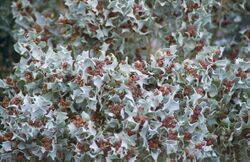Biology:Atriplex hymenelytra
| Desert holly | |
|---|---|

| |
| Scientific classification | |
| Kingdom: | Plantae |
| Clade: | Tracheophytes |
| Clade: | Angiosperms |
| Clade: | Eudicots |
| Order: | Caryophyllales |
| Family: | Amaranthaceae |
| Genus: | Atriplex |
| Species: | A. hymenelytra
|
| Binomial name | |
| Atriplex hymenelytra Torr. ex S.Wats.
| |
Atriplex hymenelytra, the desert holly, is silvery-whitish-gray shrub in the family Amaranthaceae, native to deserts of the southwestern United States.[1]:141[2]:271 It is the most drought tolerant saltbush in North America.[2] It can tolerate the hottest and driest sites in Death Valley, and remains active most of the year.[2]
The common name refers to the leaves that are shaped similar to holly, but the plants are not related.[1]:141 The toothed leaves and the small reddish[citation needed] fruits borne on the plant give it a passing resemblance to the unrelated European holly.[3]
Range and habitat
Desert holly grows in alkaline locations such as desert dry wash and creosote bush scrub in the Mojave Desert and Sonoran Desert down to Baja California.[1][2][3] In the Sonoran Desert it grows in northwestern Mexico, western Arizona, and southeastern California to southwestern Utah, and can be found at elevations ranging from 250 to 3,900 feet (76 to 1,189 m).[1]:141
With dry soil, it can survive temperatures as low as −10 °F (−23 °C); however, it dies if the ground freezes.[4]
Description
Growth pattern
Atriplex hymenelytra is generally a compact, rounded bush, 8 to 48 inches (20 to 122 cm) tall, covered in distinctive reflective silver-gray, twisted, oblong, many-pointed leaves.[1]:141[2] It drops its leaves drought deciduous in extreme drought conditions.
It tolerates alkaline soil, salt and sand.[4] The leaves accumulate salts which helps extract water from the soil when other plants cannot.[4] Salt is shed by dropping the leaves.[4] It can live in up to 30 ppm Boron in solution, compared to most plants which can tolerate only about 1-5 ppm.[4] As with other desert climate members of the genus Atriplex, it uses water conserving C4 photosynthesis, and it removes salts by having bladders in the leaves that keep the salt from the plant cells.[4]
Roots, stems, and leaves
Inflorescence and fruit
It blooms from January to April in the Sonoran Desert.[1]:141
Plants are either male or female in their natural dry, desert habitat.[1]:141 When artificially transplanted to cooler and wetter climates, male and female flowers may occur on the same plant.[2]
Female flowers are green.[1]:141
Green or red fruits occur in dense clusters enclosed in disc-shaped leaf-like bracts, with the 2 round bracteoles pressed together,[1]:141 after flowering.[3]
Ecology
Human uses
Plants were once used as Christmas decorations by drying and dying them.[1]:141 The plants are not a protected species in most habitats.[1]:141
References
- ↑ 1.00 1.01 1.02 1.03 1.04 1.05 1.06 1.07 1.08 1.09 1.10 Wildflowers of the Sonoran Desert, Richard Spellenberg, 2nf ed, 2012, ISBN:9780762773688
- ↑ 2.0 2.1 2.2 2.3 2.4 2.5 Mojave Desert Wildflowers, Pam Mackay, 2nd ed.
- ↑ 3.0 3.1 3.2 http://ucjeps.berkeley.edu/cgi-bin/get_JM_treatment.pl?3084,3089,3112 Jepson
- ↑ 4.0 4.1 4.2 4.3 4.4 4.5 Atriplex hymenelytra, Las Pilitas Nursery
External links
| Wikimedia Commons has media related to Atriplex hymenelytra. |
- Jepson Manual Treatment - Atriplex hymenelytra
- USDA Plants Profile: Atriplex hymenelytra
- Atriplex hymenelytra - Photo gallery - U.C.CalPhotos
Wikidata ☰ Q4817592 entry
 |

